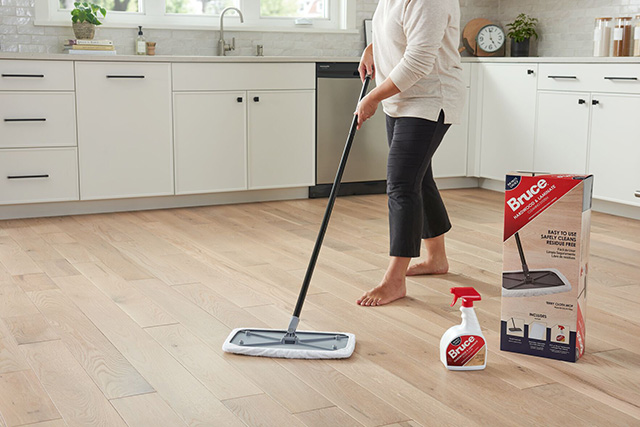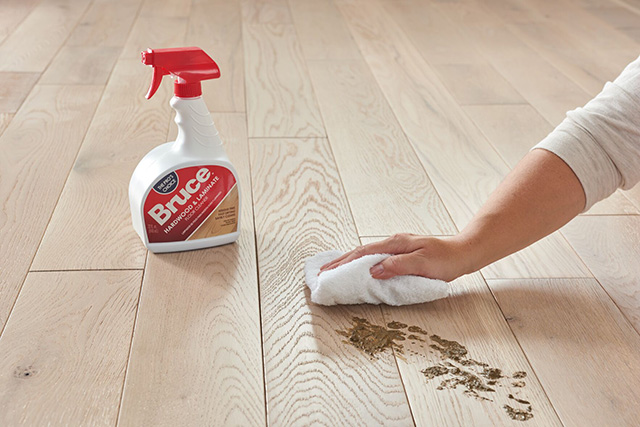How to Clean Wood Floors
If you’re going to make the investment in hardwood flooring, you’ll need to educate yourself with the best way to clean wood floors. And often knowing what not to do is as important as knowing what to do. Another key component to keep in mind is taking preventive measures to protect your wood floors. Remember, with proper care, your hardwood flooring really can last your lifetime.
Preventive Measures to Preserve Your Hardwood Floors
Tracked-in dirt presents one major enemy for your wood flooring. Your shoes and pets can bring all types of debris into your home that can mar your hardwood – mud, water, tiny stones, de-icing agents, and more. So, your best bet is to control that debris.
Start by putting floor mats inside and outside entryways. Mats trap debris and absorb water so they’re not carried onto your hardwood floors. In addition, set up a boot removal station so they can be removed before they track water and debris onto your flooring. If you’re serious about keeping your hardwood intact, you might want to remove your shoes regardless of weather conditions.
Use area rugs and floor protectors to prevent blemishes on your hardwood. They’ll help eliminate scratches and indents on your hardwood floors. That’s especially true in high-traffic areas where you run the greatest risk of getting marks on your floors.
These tactics help reduce the amount of work you’ll face when it comes to cleaning wood floors. Now, let’s get down to how to clean wood floors.
Routine Cleaning of Wood Floors
You might want to condition yourself to do a weekly touchup. But how often you clean your wood floors depends on the amount of traffic it receives. As a result, you might want to focus your efforts on high-traffic areas like your dining room or kitchen more frequently.
You can start by just using a soft-bristled, angled broom to keep debris accumulation down. The angle helps get into corners better than a straight broom. Then, of course, there’s always your vacuum for a weekly cleaning.
However, make sure you use a floor-brush attachment, and never use a beater bar that can scratch your hardwoods. If you’re looking to reduce your effort, you can even pick up a robot vacuum to do the work for you.
Once you’ve removed surface debris that can scratch your floors, you can move to a dust mop for further cleaning. It’s best to use some type of dusting agent to help pick up additional accumulations that could mar your hardwood floors. For those high-traffic areas, it’s a good idea to mop them once or twice a week.

How to Deep Clean Your Wood Floors
Weekly touchups designed to remove dust can only do so much to keep your hardwood flooring looking great. You’ll need to deep-clean your floors periodically. Again, how often you do so depends on the volume of traffic, but you should target at least four to six times annually.
To deep clean, you’ll need a wood floor mop and hardwood flooring cleaner. There’s no silver bullet for that hardwood floor cleaner. So you can select from several options, but you’ll want to use a solution with a neutral pH.
Many hardwood floor manufacturers recommend specific hardwood floor cleaners. So start by checking with them. Otherwise, you might impact the floor’s warranty if you use a hardwood cleaner that has ingredients that violate your warranty. And, although we usually recommend a commercial hardwood floor cleaner like Bruce Hardwood and Laminate Cleaner, remember that some oiled floors should not even use the Bruce cleaner as it will remove the oils.
You’ll also want to avoid oils, furniture spray, and harsh chemicals. Oils leave a residue that can attract dirt. Furniture spray creates a slick surface that could lead to slipping and falling. Chemicals create hazing.
Moreover, despite the promise of hardwood floor cleaners that claim to rejuvenate and revitalize your wood floors, you might want to steer clear. They simply put a supplemental product on your floor’s surface that lasts for a short time.
And if you are not certain, it’s best to consult with your hardwood flooring manufacturer for their recommendation on the best hardwood floor cleaner.
Go Easy on the Water
Once you’ve determined your hardwood flooring cleaner, it’s time to get started. And by the way, this process applies to solid hardwood or engineered hardwood flooring.
Remember, hardwood floors and water don’t mix. By using too much water you risk damaging your flooring. If you accidentally get too much water on your wood flooring, use a clean, dry towel to wipe it up as soon as possible.
Next, focus your efforts on cleaning small areas at a time. Let an area dry and then move on to the next. Again, you can use a clean cloth or even a dry mop to make sure they’re dry.
Removing Stains from Your Hardwood
Another key component of how to clean wood floors is stain removal. To remove stains, you’ll first need to know your floor’s finish.
With a urethane finish, stains typically remain on the surface. That makes it easy to remove them with a soft, clean cloth. You’ll never want to use sandpaper, steel wool, or chemicals. Otherwise, you risk damaging the floor even more.
For hardwood floors with an oil finish, you’ll need to remove the stain and effectively refinish the area.
For surface-level scratches, you use readily available touch-up kits. Just find the color that matches your hardwood flooring and use them according to the manufacturer’s instructions. You can also use specific crayon-type fillers.

Proper Floor Care Goes a Long Way
By understanding the basics of how to clean wood floors, you’ll be well on your way to preserving your hardwood flooring. At the very least, focus your energies on a regimen involving regular vacuuming (but no beater bar!) and dry mopping to keep damaging debris to a minimum, particularly in high-traffic areas.
You can then focus on deep cleaning using some type of hardwood floor cleaner on a quarterly or perhaps semi-annual basis. Again, let traffic be the determinant.
Bruce offers numerous hardwood floor care products including
cleaning systems, hardwood floor cleaner, floor polish, terry cloth and microfiber mop covers, and touch-up kits. You can use our retailer selector to find out where to buy our hardwood flooring products near you.
And don’t forget to check out our factory store where you can get great deals on solid hardwood flooring, engineered hardwood flooring, and rigid core SPC flooring.
